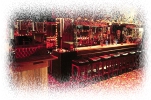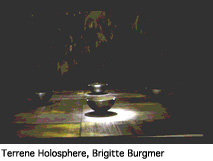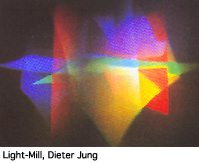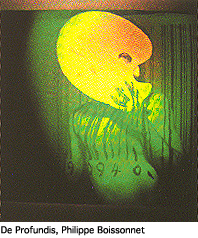


ASPECTS OF HOLOGRAPHIC ART
Holographic art has intrigued me from three different points of view: In the first place, it seemed to me a form of optical illusion that allowed a new development of the aesthetics of absence. Secondly, holographic art seemed to constitute a specific phase in the history of Light Art, which was one of my main preoccupations at a time (and is still alive in my spirit).And it appears, furthermore, that holographic art does make a distinct contribution to the problem of interactivity between the artwork and the spectator in the context of contemporary high-tech art.
Illusionist tendencies exist in art since the earliest times and were, at certain periods, even considered as forming an integral part of Western art. One can anticipate one of the specific aspects of artistic holographic illusionist techniques in expressions such as 'Op art', where scientific phenomena were consciously or intuitively used by artists to obtain illusionist manifestations with an aesthetic finality. Such manifestations included the after-image and consecutive movement; line interference; the effect of dazzle; ambiguous figures and reversible perspective; successive colour contrasts and chromatic vibration; and in three-dimensional works different viewpoints and the superimposition of elements in space.
In holographic art some of these phenomena have already been exploited, but generally only in view of the restitution of an object in the optical third dimension. However, there exists the possibility to develop these scientific-artistic phenomena in the direction of other illusionary finalities, and many artists have already shown the way, particularly those who have started to experiment with the concept of absence. One of their forerunners in Op art has been Yaacov Agam, whose life work has consisted in the artistic exploitation of what can be called the "perceptual absence of the image" and who has also produced some holographic works. Another forerunner, this time on the surrealist side, who also ventured later into the holographic area, was Salvador Dali whose paintings foreshadow the weightlessness of the holographic image and the actual absence of any light source. This luminous phenomenon of absence, which is at the heart of all holographic art, can be compared to our perception of the stars whose physical presence has been superseded by the luminous wave which reaches our eye, long after having been emitted.
The aesthetics of absence has been the privilege of the mystics of all times, but its metaphysical side is counterbalanced by its scientific connotation and several holographic artists have been prominent in the development of the latter.
 Brigitte
Burgmer, for example, has carried out research on the union of
holography and anamorphosis before producing holographic installations
such as Terrene Holosphere, in which light is creating
illusory time sequences. This work makes reference to the theory
according to which the earth represents a system which is in
permanent evolution and can consequently be regarded as a living
system. According to Brigitte Burgmer, this principle underlies
all holography because the 'whole' holography subject (the image
we view), seen from various angles, is stored in every separate
unit of the holographic master.
Brigitte
Burgmer, for example, has carried out research on the union of
holography and anamorphosis before producing holographic installations
such as Terrene Holosphere, in which light is creating
illusory time sequences. This work makes reference to the theory
according to which the earth represents a system which is in
permanent evolution and can consequently be regarded as a living
system. According to Brigitte Burgmer, this principle underlies
all holography because the 'whole' holography subject (the image
we view), seen from various angles, is stored in every separate
unit of the holographic master.
For John Kaufmann, the specialist in multi-coloured reflection holography whose work makes allusion to the tension of internal geologic forces, the greatest potential of holography lies in its position mid-way between reality as we see it and a version of reality that we are able to record. Let us add, that Margaret Benyon, a pioneer in holographic art, produced, at an early stage, 'non-holograms' showing motion invisible to the naked eye.
The aesthetics of holography is, to my mind, also very closely related to the history of Light Art. Without actually alluding to this temporal aspect, Peter Zec and others have remarked that the hologram is not only a product or a tool, but that its manifestations are based on the structure of its medium, light. They maintain that holographic space cannot copy reality, and that the effect of holographic space, as well as its substantial existence, derive solely from the self-creating energy of light to which holography gives absolute reality. As light is not only a generative principle but a subject and the basic substance of the holographic image as well, the self-reference of light represents an essential form for the articulation of the holographic message. Independent of colour pigments and the referential relation to material reality, holography opens up a wide spectrum for aesthetic realisation.
If we replace holographic art within the history of Light Art we discover some even more important characteristics. The history of luminescence in art can be traced from a date when its phosphorescent qualities were put into focus, to the present, when the beam of the laser has found various artistic uses and among them an essential application in holographic art.
Although one can find some significant antecedents in colour organs and in the uses of light on the stage and in the cinema in the second half of the 19th and at the beginning of the 20th Century, Light Art as a recognisable artistic tendency, emerged only in the early 1920s with Thomas Wilfred's art of Lumia in which he was aiming at an independent, and preferably silent, luminous art. This was followed by Moholy-Nagy's Light Space Modulator which was conceived as research on the borderline between the plastic arts and the cinema and inaugurated an artistic dialectic between light and shadow. In the 195Os and 196Os, Light Art strongly established itself with the aid of luminokinetic artists and artists who introduced neon lighting into their works. Nicholas Schöffer and Frank Malina tried to integrate moving structures in an aesthetic whole or to create new visions of the universe, whereas Martial Raysse, Joseph Kosuth, Bruce Nauman and Dan Flavin, were trying to draw attention, simultaneously, to the artificiality of modern times and to the purity and innocence of a new way of life; they also used neon structures for the purpose of a critical commentary on language mechanisms or to explore the phenomenon of colour perception in space. Since the late 1960's artists have exploiting the laser, with its concentrated and coherent light beam capable of being directed in a defined space, its spectacular properties for theatrical performances and large-scale displays in urban settings. Light Art developed into an environmental and multidisciplinary medium. But it was the predominant role of the laser used in holography that offered Light Art a new departure.
 So
far a certain number of holographic artists have put the accent
on the aesthetic possibilities of light. Dieter Jung, for example,
produces multi-exposure holograms which project their colour
fields in front of, or behind, the image plane. They are experienced
as a spatially indefinable artistic effect of changing colourful
shadows of light which melt into air. Georges Dyens, holography
is both real and immaterial, illusionistic and magical. Coloured
light, symbolic of spirituality, plays an essential part in his
large-scale installations. When Michael Wenyon and Susan Gamble
present their images of the universe, they are, in the first
place, interested in capturing light as a concrete phenomenon
presented through the hologram in its original state. On the
other hand, Andrew Pepper in his holographic monoprints , succeeds
in getting light to pass though the hologram by removing some
of the surface of the holographic plate and thus form new luminous
drawings on the surface behind, or rather 'release' them from
that surface.
So
far a certain number of holographic artists have put the accent
on the aesthetic possibilities of light. Dieter Jung, for example,
produces multi-exposure holograms which project their colour
fields in front of, or behind, the image plane. They are experienced
as a spatially indefinable artistic effect of changing colourful
shadows of light which melt into air. Georges Dyens, holography
is both real and immaterial, illusionistic and magical. Coloured
light, symbolic of spirituality, plays an essential part in his
large-scale installations. When Michael Wenyon and Susan Gamble
present their images of the universe, they are, in the first
place, interested in capturing light as a concrete phenomenon
presented through the hologram in its original state. On the
other hand, Andrew Pepper in his holographic monoprints , succeeds
in getting light to pass though the hologram by removing some
of the surface of the holographic plate and thus form new luminous
drawings on the surface behind, or rather 'release' them from
that surface.  Philippe
Boissonnet too, has stressed the importance of luminous design
in holographic works and installations, but he is also interested
in the link between luminous phenomena and interactivity, in
particular as regards the relationship between the spectator's
ocular vision, his eyes, and the rest of his body.
Philippe
Boissonnet too, has stressed the importance of luminous design
in holographic works and installations, but he is also interested
in the link between luminous phenomena and interactivity, in
particular as regards the relationship between the spectator's
ocular vision, his eyes, and the rest of his body.
In fact, interactivity has become an important theme in all branches of high technology art. It has a history, not only because of its use in 'happenings', 'actions' and 'events', but also in optical and kinetic manifestations conceived by such artists as Agam or the Groupe de Recherche d'Art Visuel de Paris. A similar situation existes in Communication Art, such as Roy Ascott's telematic media projects with 'dispersed authorship' or Fred Forest's critical propositions involving the staging of a physical presence at a distance. These works combine the telescoping of the immediate and the delayed, as well as the combination of memory and real time. This is also the case in Computer Art and particularly in Virtual Reality Installations, such as Jeffrey Shaw's Virtual Museum and Scott Fisher's Viewing System which offer, through artificial devices and interfacesthe opportunity to experience virtual space, whereas the systems conceived by Monika Fleischmann are designed to actively involve people, through natural human interfaces and representations.
In holographic art similar problems
arise with regard to interactivity. Philippe Boissonnet sees
the relationship between holography and interactivity primarily
in the diversity and multiplicity of the points of view of the
spectators. This allows them to perceive, in a privileged way,
the complexity of information surrounding them. Douglas Tyler, however, considers that holography is, above all,
an interactive medium, one in which the artist, the artwork and
the viewer share in a dynamic and symbolic relationship. He has
observed that "as we travel through the diaphanous space
of a hologram, we converse with our mutual existences".
Another prominent holographic artist, Rudie Berkhout, confirms
the view that what is unique about holography is that the image
is simultaneously present and absent, depending on the viewer's
position. Being able to see the work from the sides and from
behind allows the viewer to examine and consider all angles of
the image and finally to reach subtle levels of perception.
Douglas Tyler, however, considers that holography is, above all,
an interactive medium, one in which the artist, the artwork and
the viewer share in a dynamic and symbolic relationship. He has
observed that "as we travel through the diaphanous space
of a hologram, we converse with our mutual existences".
Another prominent holographic artist, Rudie Berkhout, confirms
the view that what is unique about holography is that the image
is simultaneously present and absent, depending on the viewer's
position. Being able to see the work from the sides and from
behind allows the viewer to examine and consider all angles of
the image and finally to reach subtle levels of perception.
Given all the achievements of holographic artists to date and all the possibilities of further research and developments in this area, how does one explain the relative absence of holographic art in private and public collections and in exhibitions and artistic manifestations in general ?
There is no doubt that the fact that holography has been largely used for what can be described as Kitsch gadgets or at least as mass-produced first-degree images has influenced museum directors, gallery owners and even the general public to think that all holographic images are of that nature, in other words that these images cannot go beyond a simple, visual, surprising impact and attain an aesthetic quality. They ignore the fact that holography has become a flexible medium rather than a cold reproduction system.
Other reasons for the neglect of holographic art can be found in the relative difficulty in presenting these artworks and in the high cost of their production. However, one can partly attribute the lack of recognition of holographic art to the many artists who are too often satisfied with the quest for technical excellence or innovation (sometimes without actually dominating these techniques) and who do not develop the aesthetic content of their production. The fact that very few art critics and art historians interest themselves in this art form can also be seen as a limiting factor. Perhaps one can note some progress in this respect lately and it could be hoped, for example, that the report on "The State of Holographic Art in France and Abroad" which was submitted by Marc Piemontese to the Ministry of Culture in Paris in June 1995 has opened new avenues, at least in France.
But the general outlook for holographic art can also be considered as favourable. The creation of large-scale holograms, sometimes ten metres in depth, the combination of numerical information with holographic techniques, the development of the temporarily neglected stereoscopic vision with the aid of liquid crystal screens or video techniques, are all helping to move the medium forward. An aesthetic finality, such as the creation of a human silhouette from a written text (as projected by artists like Pascal Gauchet and François Mazzero at their laboratory in Lyons), are among the most recent encouraging aspects of the progress in holographic art research .
It is clear that more and more artists are no longer satisfied producing three-dimensional images of the first degree. they are exploring the whole spectrum of ethereal colour and light effects, spatial and environmental issues and new ways of implicating the spectator, physically and psychologically. One can hope that holographic art will enter the process of integration into the contemporary art scene, already started by other branches of high-tech art such as the rapidly developing area of Virtual Art, without completely loosing its specific identity.
In which way has the International Symposium, Art in Holography 2, held in Nottingham in September 1996, helped to make progress in this respect ?
Combined with other recent outstanding holographic events such as the Holographic Network exhibition and symposium held at the Academy of Art in Berlin in the autumn of 1996 as well as a number of major exhibitions and realizations by certain holographic artists since then, one can say that an important step forward has been taken both on the level of the globalizing awareness of the breadth of the practical and universal development of research in holographic art and on the level of its theoretical and critical assessment.
As regards the former, the wealth of holographic experimentation can be gathered from the work shown at these recent manifestations by various artists under su °ch different headings as Photo and Lasergrams, Holographic Networks, Holographic Light Sculptures and Installations, Magic Reality in Holography, Mixed Media Installations, Holography across Media Boundaries, Multimedia holography, Reinvented Landscapes ( such as the Virtual Scapes of Georges Dyens), Time Versus Space, Holographic Kinetics, Aesthetic Dimensions, the Relations between Art,Concept and Vision, Documentary Holography, Holography's Window View upon Digital Reality (as seen by Stephen Benton), The Immateriality of Light and the Experience of Time (earmarked by Vito Orazem as the present main areas of research by holographic artists).
However what was at stake was first of all the artistic qualities in these manifestations, i.e. in which the crucial question of the borderline between art and non-art found some satisfactory answers. Without being able to cover all the events that have recently teken place in this area nor all the artists who have made outstanding contributions in this respect, let me mention only such manifestations as the retrospective exhibition of Harriet Casdin-Silver at the DeCordova Museum at Lincoln,Mass. in September 1998, Paula Dawson's latest large-scale holographic realizations in Australia, Margaret Benyon's most recent phase in her work (the Cornucopia Series. ) , Andrew Pepper's one man show at the University of Coventry, Sally Weber's environmental works in Germany,Philippe Boissonnet's exhibition Galileo,and other Uncertainties in Madrid,and Eduardo Kac's realizations in and outside the field of holopoetry.
As regards the theoretical development
in the area of creative holography,it has been suggested by Rebecca
Coyle in an excellent review of the Nottingham Symposium, that
it would be relevant of the genesis of art holography to take
more into account artists' practical investigations such as perspective
or kinetics. Coyle is certainly right in thinking that conceptual
explorations occurring in conjunction with the process and production
methods of contem porary artist holographers and art holography
would bridge the semantic and theoretical gap in critical analysis
of holographic works. However one cannot neglect the aesthetic
or the historical approaches which allow the global assessment
of the creative achievements of holographic artists, their replacement
with regard to other cultural endeavours, an analysis of their
origins and their past, present and prospective position, as
well as their impact and stimulating potential on the spectator.
I should like to quote here a very personal example.When asked
to provide some essays for the St.James Guide of Contemporary
Women Artists to be published in 1998-99, I managed to introduce
three assessments of holographic artists (Benyon,Casdin-Silver
and Dawson), based on the study of their main creative periods
and their historical positioning, in the hope of contributing
in this way to a more general insertion of creative holography
into the present art scene.
Of course this is not the place to discuss the impor tant contributions
in the theoretical field of such art critics as Edward Lucie-Smith
and Jasia Reichardt who attended the Symposium at Nottingham
or of outstanding specialists and exhibition organizers like
René Paul Barilleaux, among many others, but let me mention
the venue of a relatively new type of person that has emerged
in the area of technological art, one who combines his activities
as an artist with that of teacher and of organizer of exhibitions
and symposia. In Holography at least three personalities have
emerged in this respect, Douglas Tyler, Andrew Pepper and Dieter
Jung. One can venture the opinion that progress in creative holography
is closely linked to their present and future projects and realizations.